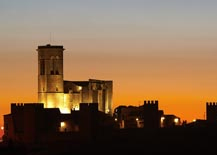
Locality: ARTAJONA (31140)
Address: Calle San Saturnino
Zone: The Central Zone
Style: Romanesque
Centuries of construction: XI-XIII
Visiting hours: El recinto amurallado se puede visitar durante todo el día. La iglesia permanece cerrada.
Price of the visit: Acceso libre
Descrizione
Perfectly adapted to the profile of the small hill on which it stands, the Cerco (old walls) of Artajona offer the visitor the opportunity to enjoy the most important medieval fortification in the Central Zone of Navarre.
A stroll inside reveals an 11th-century walled town that originally had fourteen crenelated towers, although only nine of these remain, joined by the battlemented parapet.
Accesso
You reach the enclosure through one of the two old gates that are still conserved (San Miguel and Remahua), which take you back in time to the Middle Ages.
It is easy to imagine the place inhabited by monarchs, noblemen on horseback, minstrels, bishops and farm workers in heavy clothes.
Relive the past and try and imagine what life was like in this place, crowned by the fortress-church of San Saturnino, a sold and imposing building from the 13th century that has been declared a Historical-Artistic Monument.
The highest part of Artajona offers a view of an impressive walled enclosure scattered with crenelated towers that blends in with the landscape of fields that surround the town. The origin of this fantastic fortress, known as “El Cerco”, goes back to 1085, when building work started under the orders of the clerics of Saint Cernin of Toulouse. This work was completed in 1109.
Throughout the centuries monarchs, lords and clerics coveted the town and this led to a number of struggles that brought about the reconstruction of the fortress on many occasions, particularly during the reign of Carlos II “el Malo” (14th century).
After climbing up the steep slopes that lead up to the walls the visitor can enter the enclosure through two ancient gates, San Miguel and Remahua. The robust masonry walls were watched over by fourteen lookout towers, of which nine have been conserved. They are cubic in shape and have merlons, and are joined together by the 12th-century wall and a battlemented parapet.
The fortress-church of San Saturnino
The enclosure protects the fortress-church of San Saturnino (Saint Cernin), which, apart from acting as a bell tower, was an important lookout post. Built in the 13th century on the ruins of an old Romanesque church, it was part of the defensive system of the town. This is clear from its robust walls and buttresses, the battlemented parapet over the dome of the nave that served as a dungeon, the well, the use of the vestry as a prison and the 14th-century prismatic tower that was used as a sentry post in the 15th century.
The fortress-church is usually closed, but perhaps its most interesting features are on the outside. Particularly notable is its monumental Gothic facade from the end of the 13th century. Twelve richly decorated archivolts surround the tympanum, where the figures of the martyrdom of San Saturnino and of Queen Juana de Navarra and her husband Felipe ?el Hermoso’ are carved.
If your visit coincides with the occasional opening of the church you will be able to see a Gothic altarpiece made between 1505 and 1515 that has a carving of San Saturnino sitting down, a Gothic carving of the Virgin Mary and Child, and a Hispano-Flemish Gothic carving that is rounded off by paintings and a lot of gold. The apse also contains interesting Gothic murals.
After visiting the fortified enclosure, pass by the imposing caserío (farmhouse) of Artajona on the side of the hill and enjoy an impressive view over the whole medieval town.







